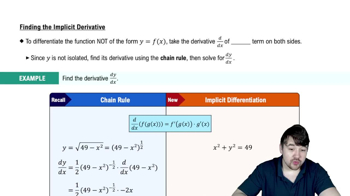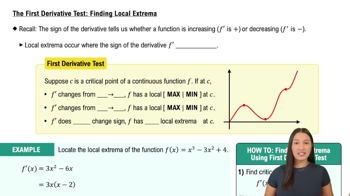Table of contents
- 0. Functions7h 52m
- Introduction to Functions16m
- Piecewise Functions10m
- Properties of Functions9m
- Common Functions1h 8m
- Transformations5m
- Combining Functions27m
- Exponent rules32m
- Exponential Functions28m
- Logarithmic Functions24m
- Properties of Logarithms34m
- Exponential & Logarithmic Equations35m
- Introduction to Trigonometric Functions38m
- Graphs of Trigonometric Functions44m
- Trigonometric Identities47m
- Inverse Trigonometric Functions48m
- 1. Limits and Continuity2h 2m
- 2. Intro to Derivatives1h 33m
- 3. Techniques of Differentiation3h 18m
- 4. Applications of Derivatives2h 38m
- 5. Graphical Applications of Derivatives6h 2m
- 6. Derivatives of Inverse, Exponential, & Logarithmic Functions2h 37m
- 7. Antiderivatives & Indefinite Integrals1h 26m
- 8. Definite Integrals4h 44m
- 9. Graphical Applications of Integrals2h 27m
- 10. Physics Applications of Integrals 2h 22m
4. Applications of Derivatives
Implicit Differentiation
Problem 3.8.52
Textbook Question
51–56. Second derivatives Find d²y/dx².
2x²+y² = 4
 Verified step by step guidance
Verified step by step guidance1
First, identify the given equation: \(2x^2 + y^2 = 4\). This is an implicit function of \(x\) and \(y\).
Differentiate both sides of the equation with respect to \(x\) to find the first derivative \(\frac{dy}{dx}\). Use implicit differentiation: \(\frac{d}{dx}(2x^2) + \frac{d}{dx}(y^2) = \frac{d}{dx}(4)\).
Calculate the derivatives: \(\frac{d}{dx}(2x^2) = 4x\) and \(\frac{d}{dx}(y^2) = 2y \frac{dy}{dx}\). The right side derivative is zero since \(4\) is a constant.
Set up the equation from the derivatives: \(4x + 2y \frac{dy}{dx} = 0\). Solve for \(\frac{dy}{dx}\) to find the first derivative.
Differentiate \(\frac{dy}{dx}\) again with respect to \(x\) to find \(\frac{d^2y}{dx^2}\). Use the quotient rule or implicit differentiation as needed, and substitute \(\frac{dy}{dx}\) from the previous step into this new derivative.
 Verified video answer for a similar problem:
Verified video answer for a similar problem:This video solution was recommended by our tutors as helpful for the problem above
Video duration:
9mPlay a video:
Was this helpful?
Key Concepts
Here are the essential concepts you must grasp in order to answer the question correctly.
Implicit Differentiation
Implicit differentiation is a technique used to differentiate equations where the dependent and independent variables are not explicitly separated. In this case, the equation 2x² + y² = 4 involves both x and y, making it necessary to differentiate both sides with respect to x while treating y as a function of x. This allows us to find the first derivative dy/dx before proceeding to the second derivative.
Recommended video:

Finding The Implicit Derivative
First Derivative
The first derivative, denoted as dy/dx, represents the rate of change of the dependent variable y with respect to the independent variable x. It provides information about the slope of the tangent line to the curve defined by the equation at any given point. To find the second derivative, we first need to compute the first derivative using implicit differentiation.
Recommended video:

The First Derivative Test: Finding Local Extrema
Second Derivative
The second derivative, denoted as d²y/dx², measures the rate of change of the first derivative. It provides insights into the curvature of the function, indicating whether the function is concave up or concave down at a given point. To find d²y/dx², we differentiate the first derivative again, applying implicit differentiation as necessary to account for the relationship between x and y.
Recommended video:

The Second Derivative Test: Finding Local Extrema

 5:14m
5:14mWatch next
Master Finding The Implicit Derivative with a bite sized video explanation from Nick
Start learningRelated Videos
Related Practice


